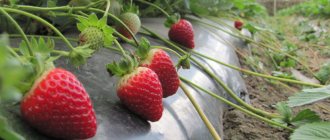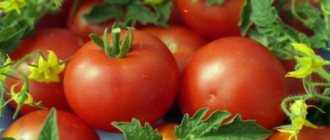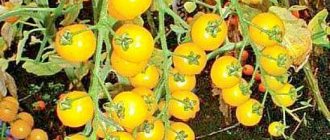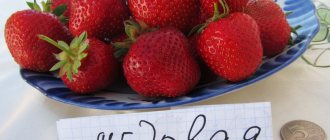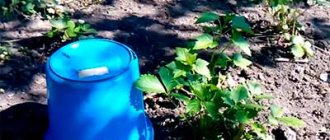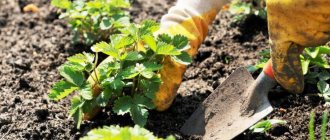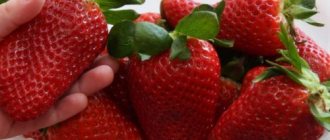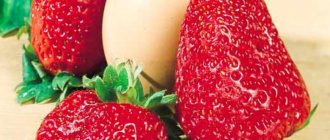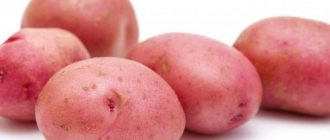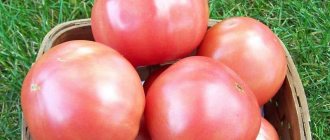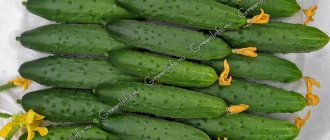Strawberry Lord is a large-fruited garden strawberry variety of British selection that appeared in Russia in the late 80s of the last century and quickly spread throughout the country. The popularity of Lord is explained by the unpretentiousness of the plant and the fruits of universal use - large, juicy, dense and unusually tasty.
Description of the variety
Strawberries Lord are classified as varieties of medium or medium-late fruiting: in the Central region, the ripening of berries occurs over a rather extended period - from the last ten days of June to mid-July (3-4 weeks).
- Spreading Lorde strawberry bushes reach a height of 60 cm. Large leaves of light green color have a wrinkled texture with ribbed edges.
- During the flowering period (late May - early June), the bush forms from 10 to 15 strong peduncles, on each of which 5-6 ovaries develop. Since large Lord's berries can reach a weight of 90...100 g, the peduncles lie down under the load of fruit. It is recommended to place them on supports. Mulching beds with straw also prevents crops from coming into contact with the soil.
- Lord is rightfully considered one of the largest-fruited varieties: the average weight of berries is 15...30 g, in favorable conditions the fruits often reach 90...100 g.
- The shape of Lord's berries can be called rounded-obtuse, the fruits are wide and slightly flattened. The bright red color of the berry also remains intense red when cut.
- The pulp is juicy and at the same time dense, which is important for transporting the harvested crop. The taste qualities of the Lord variety are rated 4.6...4.9 points out of 5 possible. The berries contain up to 11.3% sugars, 1.37% acids and 54 mg% ascorbic acid (vitamin C).
- Multipurpose berries are suitable for fresh consumption, processing and deep freezing.
- The yield of the variety reaches 1.5 kg per bush, which in terms of area is 150...190 c/ha.
- Strawberry bushes Lord tolerate the winter of the Middle Zone well - down to -26 degrees below zero.
- The variety is practically not susceptible to fungal and bacterial diseases, and is little damaged by the strawberry mite.
Reproduction and necessary agricultural technology
Strawberry bushes of the "Lord" variety produce a large number of tendrils and reproduce well by daughter rosettes, so other methods (dividing bushes or germination from seeds) are rarely used. On plants not intended for seedling production, the tendrils must be removed in order to achieve maximum yield and prevent rapid thickening of the plantings. To obtain high-quality seedlings on healthy annual bushes, in which varietal characteristics are maximally expressed, it is recommended to leave 2-3 of the most powerful tendrils and take first- and second-order rosettes from them.
On fruit-bearing bushes, it is necessary to remove the tendrils, directing all the plant’s forces to forming ovaries and filling the berries.
It is recommended to place “Lord” strawberry seedlings in a checkerboard pattern at a distance of at least 60 cm from each other. This way the plants will receive sufficient nutrition area, good ventilation and adequate lighting. The soil between the bushes must be cleared of weeds and loosened, preventing the formation of a surface crust, or mulched. Natural (pine needles, straw, sawdust, etc.) or artificial (film, agrofabric) materials are used as mulch.
Planting of seedlings is carried out in early spring after the cessation of frost or in August - September. It is important that young plants have time to take root well before the onset of frost. To maintain stable yields and obtain large, sweet berries, Lord strawberries need to be regularly watered and fertilized. To enrich the soil, it is recommended to use mature organic matter (humus, rotted manure or a solution of bird droppings).
Regular watering is especially important during the initial stages of growth, flowering and ovary formation, as well as during periods of heat and drought.
To prevent and protect plants from diseases and pests, many gardeners prefer to use traditional methods rather than “chemistry”: treating bushes with hot water (+65 ℃) or a solution of potassium permanganate, planting parsley, garlic, calendula or marigolds between rows.
a brief description of
Advantages of the variety
- long fruiting of the bush (up to 10 years);
- high yield of large, universal berries;
- excellent taste of berries and beautiful presentation;
- high ability to form whiskers (no problems with planting material);
- high winter hardiness (up to -26 degrees);
- the variety is resistant to fungal diseases and gray rot;
- Lord practically does not need treatment against strawberry mites and other insects.
Disadvantages of the variety
- increased mustache formation requires control over their growth and timely removal of excess;
- poor drought resistance;
- the variety is demanding on growing conditions (humidity, light);
- Lord strawberry bushes reach their maximum yield only after the 3rd year of growth.
Strawberries Lord often have hollow fruits. If you are looking for large-fruited strawberries without voids, we recommend paying attention to the Darselect variety.
Landing
The unpretentiousness of Lord strawberries, so much praised by gardeners, is very conditional. The berry bush will take root and can grow in any conditions, only its yield will be 3 times lower - not 1.5 kg. berries, and 300-500 grams. What should you consider first to get the most out of your strawberry patch?
Theoretically, there is no preference in the timing of planting seedlings: plants planted in autumn and spring take root with equal success. It is only necessary to take into account the variety’s requirements for soil moisture. If in early spring the soil is saturated with winter water and practically no additional watering is required, then young plants planted at the end of August/September require careful and frequent watering. Urban summer residents who frequently visit the site should pay attention to this fact.
Strawberry Lord requires moderate soil moisture for optimal growth - the bushes grow poorly and get sick both in too dry areas and in damp places. The best place for strawberries is a flat area or a slight slope towards the south, which is always well warmed by the sun.
Important! With a lack of sunlight (under all other favorable conditions), the berries do not gain sugars and remain sour in taste, even being uniformly colored red.
Strawberry Lord does not have a particular preference for the type of soil - well-drained, loose, fertile soil rich in organic matter is suitable. To enrich the soil with nutrients, it is best to use natural fertilizers:
- per 1 m2 of bed (or 1 running meter of row) add 1 bucket of compost or crumbly humus, improve the mineral composition of the soil with wood ash - approximately 0.5 liters.
Rules for planting large-fruited strawberries of the Lord variety:
- For autumn planting, the bed is prepared in advance: weeds are removed, the soil is fertilized and dug up. For spring planting of strawberries, the site is prepared for the winter (you can postpone the preparation until October).
- Seedlings of a large-fruited variety must be planted with an interval between plants of 50...60 cm; when planting in rows, a row spacing of 60...80 cm is left.
- When planting, seedlings should not be buried - the central rosette should be at soil level.
- The planted row of strawberries must be well covered with mulch. This will protect the soil from drying out, saving the gardener from frequent watering and loosening the beds. In the future, the mulch will inhibit the growth of weeds and protect the strawberries from contact with the soil.
Helpful advice! To prevent fungal diseases and repel insect pests, it is recommended to plant spicy-fragrant plants - garlic, onions, parsley, calendula or marigolds - in the aisles of strawberries.
Care
In the first year, strawberries are not fed. She needs to adapt to the climate and land, so feeding will only reduce her immunity.
Starting from the second year of cultivation, the bushes are fed 2 times a year:
- Nitrogen fertilizer is introduced for the first time. Dilute tbsp. nitrophoska in a bucket of water and water the strawberries from a watering can no later than the end of May;
- The second feeding is carried out during flowering. Stir tbsp. potassium sulfate in a bucket of water and water the beds. These fertilizers will be enough to form a good harvest with an earlier ripening period.
In the spring, approximately in mid-May, strawberries are prevented from pests and insects. The main condition is to carry out the treatment before fruiting begins, otherwise the berry will be spoiled. Any broad-spectrum insecticidal additive is suitable for repelling insects. It is used according to the instructions.
Important! To repel insects, fragrant plants are often planted near the strawberry bed - onions, garlic, lemon balm, mint.
Water the berries regularly, but as the soil dries out. Usually, if the weather is good in the summer, it is enough to water the strawberries 3-4 times a week. In cloudy weather, you can refuse watering.
After the soil is moistened, it is loosened a little and weeded to remove excess grass. Weeds slow down the growth of the bush and take nutrients from the ground. To maintain moisture in the soil and to protect against overheating, after watering, straw or sawdust is poured in a thin layer near the bushes.
Growing and care
Concerns about planting strawberries are minimized if the strawberry bed is generously covered with organic mulch. Tedious weeding, watering and loosening the soil are not at all necessary. Even installing supports for fruit bearings with heavy berries can be ignored - mulch will protect the fruits from contamination and rot. Not much is required from the gardener:
- Mandatory watering of the strawberry beds on the eve of flowering and during the fruiting period. The frequency of watering is determined by the condition of the soil - the soil squeezed into the palm of your hand should form a crumbly lump, but not fall apart immediately.
- When the mustache appears, they are not allowed to develop - they are cut off, not pulled out. The formation of layering takes away strength from the plant and reduces yield. Therefore, on fruit-bearing beds, the mustache is removed in a timely manner.
- Strawberries are fertilized in 2 steps: early in the spring, organic matter is given between the rows for digging, and after harvesting, they are fed with complex fertilizers for berry crops such as Agricola.
After harvesting and autumn mineral fertilizing, the Lord strawberry bed is almost ready for winter. In the Central region (even more so in the south), the strawberry bed overwinters well under the snow.
Attention! Contrary to popular belief, you should not mow the leaves from your strawberry bed after harvesting. Instead of preparing for winter, bushes grow young foliage and enter winter weakened. In addition, old leaves retain snow and serve as additional protection from frost.
How to care for plantings
We recommend reading our other articles
- Pepper variety Fat Baron
- The best varieties of yellow peppers
- Grape diseases
- The best meat chicken breeds
Depending on the size of the plot with strawberries, planting and climate zone, caring for strawberries may differ in some respects. Below is a general idea of how to care for Lord strawberries in order to harvest large harvests each year.
Photo of strawberry Lord on agrofibre
- Irrigation is carried out by sprinkling. But if possible, you can install a drip system (it is popular on large plantations). The soil should never dry out, but during the fruiting period, plants are watered much less frequently than when flowers and ovaries first appear.
- Weeding and removing weeds is an important point in caring for the Lord strawberry variety if it does not grow on agrofibre. Weeds clog the soil and suck out all the nutrients from it - hence the low yield and the abundance of pests and diseases. So, as weeds appear, you need to pull them out, and throughout the year, and not just in early spring, when the strawberries are growing.
- Mulching is one way to make growing easier. Mulch nourishes the soil, prevents large amounts of water and nitrogen from being lost, and also helps reduce the number of weeds to a minimum.
- To increase productivity or obtain a large number of mustaches, you need to properly process the bushes of the crop. So, in order to get a lot of tendrils for further propagation of the variety, all flower stalks are plucked from the bush. If a harvest is needed, on the contrary, all the tendrils that appear on the bushes are plucked.
- In early spring, Lord strawberries are fed with a solution of 200 g of wood ash, 20 g of superphosphate and 10 liters of water. As an alternative, you can use simple manure (but humus is better). During fruiting, fertilizing is carried out in extreme cases, for example, if the bushes begin to turn yellow, the harvest is low. Mineral fats and herbal infusions are suitable for this. After harvesting the last harvest, you need to cut off the old leaves from the bush and generously fertilize it with humus.
Important!
If the spring is cold and sudden severe frosts are possible, you can treat the strawberry bushes with a 1-2% glycerin solution to protect the buds from freezing. This is a well-known ancient method, proven by more than one generation!
Photo of strawberry Lord in open ground
- Sometimes, as strawberry bushes develop, the root system of the plant becomes partially exposed. If this happens, you need to add soil under the bush so that the roots are not visible!
- Strawberry pests and diseases are afraid of plants such as calendula, marigolds, garlic, cloves, and parsley. If you plant them along the edges of the beds, there will be no problems with insects or viruses. For prevention, an infusion of dandelions (500 g/10 l of water) is suitable. And a simple iodine solution helps against fungal diseases. For 10 liters of water you need approximately 12 drops of iodine. Spray immediately after preparing the composition.
- For the winter, the beds are cleaned (weeds, old, dry leaves are collected) and then mulched with straw. It will protect the bushes even from severe frosts.
Reproduction
Strawberries of the Lord variety form a sufficient number of tendrils and aerial layering, for this reason there is no point in growing seedlings from seeds - the method is troublesome and time-consuming. Traditional methods of vegetative propagation of berry crops are much simpler and more effective.
- Air layering (mustache ). The variety is characterized by increased formation of mustaches - much more of them grow than is required for simple restoration of plantings. 3-4 tendrils are left on the mother bush and the flower stalks are removed so that the cuttings grow earlier and are stronger. For rooting, leave rosettes of the 1st and 2nd orders - pin them to the bed or press them with a weight until rooting is complete. If you plan to postpone replanting until spring, there is no need to separate the cuttings from the mother bush.
- Dividing the mother bush allows you to rejuvenate the plant, since only the unaged part of the rhizome is planted.
Caring for planted cuttings and bush divisions is no different. In the 1st (and even 2nd) year of cultivation, Lord strawberries do not have time to show their best properties. In the 3rd year, the bushes will gain strength and the bed will bear fruit for at least 7 years.
Characteristics of strawberry Lord
Also check out these articles
- How to properly prepare raspberries for winter
- Rhode Island chicken breed
- Carrot variety Caramel
- Dead bees
With proper care, the yield from Lord's bush is up to 1 kg
Strawberry Lord is valued for many of its qualities, but it also has a number of disadvantages. Below are its characteristic features.
- The variety is unpretentious to grow.
- There is resistance to returning spring frosts.
- There is immunity to gray rot and resistance to the effects of strawberry mites, but the variety is powerless against leaf spot.
- Fruiting is extended - from the end of June to the end of July.
- With proper care, the yield from Lord's bush is up to 1 kg.
- It is a sweet and sour variety, but if the weather is rainy when the berries ripen, they may be too sour.
- There are voids inside the berries.
Interesting!
Strawberries produce their maximum yield in the 2-3rd year of the bush’s life, and then the root system ages, the plant becomes weak and produces a low yield. This is why it is so important to update the garden bed on time.
- Strawberry Lord has high transportable qualities. It does not wrinkle on the road, does not deteriorate due to vibration and can easily withstand even long-term transportation.
- Product quality is good. Strawberries of the Lord variety are beautiful, the berries are not small, easy to process, bright, with a glossy surface.
- The variety is winter-hardy and is not afraid of severe frosts, especially in snowy winters.
Reviews
I live in Siberia. The variety may not be new, but I’m not going to give it up. Winter hardiness is just right for our region. 2 years ago there were long frosts of -40 degrees, but there was practically no snow. The lord passed the test with flying colors; the bushes did not die and bore fruit well. The berries are large, freeze well, and their shape, taste and excellent aroma are preserved after defrosting.
The Lord variety is an excellent choice for a gardener looking for large-fruited, winter-hardy strawberries. Lord has been proven over the years and is not going to give way to modern expensive new products.
